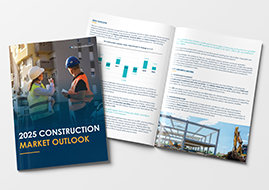By: Greg Perruzzi Joe Zinga Jon Stambaugh Rob Blasio

Introduction
January 16, 2024 — Global Construction forecasts that the volume of construction output will grow by 85% to $15.5 trillion worldwide by 2030.1 In recent years, litigation trends, a challenging labor market, building and labor cost escalation, and supply-chain disruptions have heightened the complexity of claims risk in the construction industry. In addition, the nature of construction projects in scope and components are only growing in complexity, which in turn increases insurance costs and potential liability for construction businesses and contractors. Inflation is only exacerbating insurance rates, causing the exposure units to cost more and the total cost of insurance to rise.
When thinking about top business concerns for the construction industry in 2024, it should come as no surprise to anyone that the total cost of risk (TCOR) is becoming a stronger focus area as insurance buyers are forced to take on more risk while also experiencing higher retention and higher coverage costs. These high-value claims are driving up the cost of insuring construction projects and creating new risk management challenges for contractors.
In the face of this exponential predicted growth, the industry is also experiencing a severe labor shortage of more than half a million workers, leading to the highest rate of open positions ever recorded.2 Those who are filling these positions are often new entrants into the construction industry with little-to-no experience or safety training, inflating risk and increasing loss prevention challenges. Larger projects require more workers and greater investment in safety and safety oversight. Mandatory loss prevention training, certification, and full-time project-based services continue to be driven by increased local, state, and federal regulations, insurance carrier subjectivity, or owner contractual requirements.
As proactively mitigating risk becomes increasingly important, understanding the dynamics of the claims, risk, and insurance markets is vital for organizations focused on reducing exposure and controlling costs. In this market outlook, we will identify key strategies contractors can implement to improve risk management mitigation to help achieve superior outcomes.
Key Strategies to Improve Your Construction Risk Management
Build a Culture of Wellness
While there are currently about eight million construction workers in the United States,3 growth of the workforce has stagnated, and these employees, as well as companies, are facing a high demand for projects with a limited number of resources. Both owners and builders are forced to do more with less, and for the individual workers, this labor shortage increases the physical and mental strain, with longer hours and more difficult projects. Having increased injuries and inefficiencies fosters risk exponentially and, from a worker's perspective, eliminates any sense of culture in the workplace.
This stagnation of the workforce also creates a lack of capacity to provide comprehensive and professional safety services. A growing pipeline of complex projects necessitates a competent and capable workforce — a problem that's only increased by the industry's decrease in seasoned workers. Older, more experienced workers are retiring or being displaced, and the younger generations don't have the training or skills needed to fill the gaps. Whether inexperience comes from a lack of education and mentorship or being pushed into a position above their experience level, this dynamic can create unsafe working environments in an industry that has the second highest rate of occupational fatalities, according to the US Census Bureau.4
Substance abuse continues to be prevalent among construction workforces, hovering around 15% compared to 8.6% of the general population, and presents additional challenges.5 Substance abuse has the potential to impact a worker's ability to function and, in most cases, perform safely and effectively. From a risk management approach, cognitive impairment screening can protect workers, as it assesses a person's overall well-being, including substance intake, sleep and stress levels, and even pain levels. According to the National Workrights Institute, the use of impairment testing has consistently reduced accidents and is positively received by employees, as well as employers finding that it is "superior to urine testing in achieving both of these objectives." Furthermore, providing education and wellness-support programs can help address the root cause of potentially significant incidents caused by substances on a jobsite.6
With these challenges, it's crucial to mitigate risk before incidents occur. Strategic investment in on-site health and wellness programs that train workers can contribute to building a culture where wellness is the priority from top to bottom and workers benefit from a safe, supportive work environment. Having boots on the ground in the form of on-site safety professionals is essential to oversee projects and ensure adherence to contractual safety protocols and measures. Moreover, loss prevention quality assurance consultants with expertise in safety, environmental health and safety, special investigations, and emergency medical technicians can reduce the risk for major construction projects. These professionals identify operational exposures in which existing compliance programs, methods, and records are reviewed in detail. Prioritized recommendations are then returned to improve loss prevention strategies.
Wellness programs can be a relatively low-cost, high-impact answer to attracting and retaining talent for construction businesses. Creating a culture of project-specific wellness helps ensure the labor force feels supported and part of something bigger, which can translate to better continuity of labor, higher quality of work, and lower potential of accidents on a jobsite.
Provide Preventive Safety Training and Educational Support
From compliance challenges to ensuring on-site safety, the construction industry is facing a staffing and skill set deficiency, which is increasing risk exposure. Whether focusing on safety certifications, OSHA requirements, or continuing education, providing comprehensive safety training and support can improve risk management while also reducing costs.
In 2023, OSHA updated its Fall Protection Standard to emphasize the need for comprehensive safety systems to prevent fall-related injuries, and as of January 1, 2024, OSHA has instituted more stringent record-keeping requirements with the Improve Tracking of Workplace Injuries and Illnesses final rule.7 This rule specifically addresses workplace injuries and illnesses, with requirements for more detailed logging, faster reporting timelines, and electronically submitting injury and illness.
Construction risk requires focused, well-versed industry professionals that understand the exposure and assumptions within the contracts and the nuances of the insurance policies that cover them. In our conversations with clients, it is apparent that there is a scarcity of necessary resources available in-house to confidently manage the safety of the projects they insure.
Prioritizing safety starts at the top with company leaders and filters through on-site managers. Investing in strategic, consistent safety training and safety enforcement — and even certain preventive investments can help mitigate risk, which is crucial as costs continue to rise. Better planning and ongoing support for creating holistic safety programs keeps contractors ahead of the regulatory curve while also reducing unnecessary exposure. Additionally, these initiatives can help lower workers' compensation costs, improve overall productivity and safety ratings, and provide an opportunity to discover efficiencies in work processes.
Contractors can also benefit from finding partners with risk management tools that leverage data-driven insights to build robust loss control and risk mitigation programs that focus on safety awareness, as well as provide timely information and updates to decision makers to help reduce potential claims. Qualified field services, on-site safety managers, and experienced technical support personnel can provide a wide range of consulting, regulatory compliance, and risk transfer assistance. Ultimately, partnering with experts that integrate operational loss prevention solutions delivered by industry-leading construction claims and loss control expertise assists in identifying opportunities to prevent loss and can ultimately reduce TCOR.
Leverage Technology and Prioritize Data Efficiency
Following the pandemic, the development and implementation of technology in the construction industry dramatically accelerated. Building methods, off-site fabrication, robotics, and automation shorten the project life cycle, alleviate the labor shortage, and reduce injuries and accidents on-site.
Unfortunately, the construction industry at large is lagging in adopting and implementing technology. Many contractors are still in the early stages of adopting data and technology systems at point solution (single point of data) and single project levels. As a result, the industry is still evolving to adopt data systems that incorporate operations, safety, claims, quality, and financial data into enterprise risk management systems spanning the entire portfolio of projects.
It follows that the construction industry is inherently inefficient with how data is managed, cataloged, and converted into actionable insights that can have a positive impact on TCOR and enhance contractors' ability to optimally manage exposure to loss. Leveraging the right tools and resources to distill claim data can assist in identifying safety deficiencies in the workforce and areas where safety education and training can mitigate risk on future projects.
By integrating technology and decision-support tools, projects can be completed smarter, faster, and with less risk to the workforce. For example, GB leverages Luminos, our award-winning RMIS platform, to support contractor risk management and safety operations through OSHA recording and tracking methods to help with data quality management. These innovative tools go beyond static reporting to deliver customized insights to clients through interactive, dynamic dashboards.
Additionally, we utilize our claims expertise and internal data science resources to synthesize leading and lagging factors, including operational safety tactics and loss history, to create a better risk profile with a smaller total cost of insurance and better profitability measures for construction businesses.
Conclusion
The construction industry is facing significant challenges in terms of increasing project complexity, rising costs, and a severe labor shortage, heightening the need for effective risk management strategies to mitigate liabilities and control costs. Building a culture of wellness, providing safety training and support, and leveraging technology and data efficiency are key areas for contractors to focus on. By prioritizing these strategies, contractors can improve safety, attract and retain talent, and achieve superior outcomes in a rapidly evolving industry.
To learn more about Gallagher Bassett's partnered approach for the construction industry, visit our construction industry solutions page.
Sources
1Davies, Vikki. "Global Construction Market to Grow $8 Trillion by 2030," Construction, 1 Mar 2023.
2LaRocco, Lori Ann and Natalie Rose Goldberg. "The Iconic American Hard Hat Job That Has the Highest Level of Open Positions Ever Recorded," CNBC, 29 Jul 2023.
3"Number of Employees in the Construction Industry, US January 2000 to July 2023," Statistica, 11 Sep 2023. Gated.
4"Census of Fatal Occupational Injuries Summary, 2021," US Bureau of Labor Statistics, 19 Dec 2023.
5Kaliszewski, Michael. "Construction Workers and Addiction: Statistics, Recovery and Treatment," American Addiction Centers, updated 24 Jul, 2023.
6"Maltyby, Lewis. Impairment Testing — Does It Work? "National Workrights Institute, accessed 10 Jan 2024.
7"Improve Tracking of Workplace Injuries and Illnesses," Department of Labor Occupational Safety and Health Administration, 21 Jul 2023. PDF file.
Authors
Make Gallagher Bassett your dependable partner
When making the right decision at the right time is critical to minimize risk for your business, count on Gallagher Bassett's extensive experience and global network to deliver.


